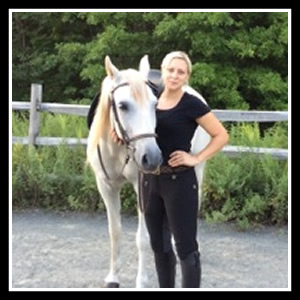The Rider’s Hands

Good morning, this is Will Faerber from Art2Ride and today we are looking at Karen Loshbaugh riding a young Arab that we started from basically barely halter broke. He is just beginning to come into the phase of just beginning to take contact with the bridle. So the question that we are going to try and answer today is: What do you do with your hands in the stretch?
Lets talk about a few concepts of that. The main thing with the hands as Mr. Olivera used to say is, “The best hands in the world simply work like a pair of side reins” (They limit the length of the rein). They simply don’t give every time the horse pulls. But better than a pair of side reins, they can actually maintain contact with the horse, and of course adjust to the horse’s stride as necessary in the length of the neck that we need at any given moment. The concept here is, we don’t lose contact with the mouth of the horse.
Notice in the video, Karen is riding with a light rein. The correct contact with the rein when the horse is correct is the weight of the rein, which simply means an unbroken line but with a sense of a positive feel. Some people think that their horse’s are light, when in fact they are actually behind the bridle and behind the bit. Very often they are broken in the third vertebrae and are therefore dropping off the bit. So in the correct contact, there is no backwards tension but there is a sense of a positive feel, that of the horse’s taking of the reins.
Notice how the horse in the video is kind of moving his head around as he is trying to find the contact with the bridle. Karen maintains contact, and when his head comes up she simply follows him up with her hands. As he stretches down, she releases the reins with the weight of the rein. Look how nicely this horse is stretching forward! Notice how she keeps that upright position and how there is almost no change in the horse’s trot at all. As he stretches down and forward, he is still engaging. Now some people who see a horse’s head down, their immediate criticism is “That horse is on the forehand”, but look how deeply this horse is stretching underneath the body, his hind legs that is. He is reaching and engaging, and not on the forehand. Now yes, compared to a horse that is up in collection he is a little more on the forehand, but he is not plugging away. A horse can be up in the bridle (what people think is on the bit) and in a false balanced frame with the horse’s back down, but what you would find is as soon as you try to go faster on a horse like that is they usually fall apart.
Notice how the hands have never been aggressive. There has never been any anger in her hands, no frustration. She is just letting the horse find the contact and when his mouth comes up she follows her hands up. If you were to press your hands down, the horse would resist even harder. So we want the horse to learn that it can’t escape the bridle, so we simply bring our hands up and then as the horse stretches back down the hands lighten back to what should be the correct weight. The horse is rewarded by giving him through the weight of the rein, that sense of a positive feel. Once she gets him back into the correct frame, she can lower her hands back down to what you might consider equitation position. Once again, this is riding for the schooling ring, this is not what we do in the show ring.
This is a horse that is just beginning to come in contact with the bridle, so it is very important for him to learn that there is no escape from the rein, but the reins are never going to brutalize the horse’s mouth. The reins are simply going to have a little more contact with him when he’s not in the frame that she wants him to be in. She will either raise her hands or widen her hands to maintain that unbroken line to the horse’s mouth. This is Will Faerber and Karen Loshbaugh from Art2Ride, thank you!
One response to “The Rider’s Hands”
Leave a Reply
Fantastic explanation! Sometimes zooming in a bit so one sees clearly that positive tension does not mean pulling back would help get your message across. Yes showing the whole picture of how the horse is going is important too but for those just learning this information, seeing a bit clearer would aid enormously. Again important topic, great explanation, nicely done.





Fantastic explanation! Sometimes zooming in a bit so one sees clearly that positive tension does not mean pulling back would help get your message across. Yes showing the whole picture of how the horse is going is important too but for those just learning this information, seeing a bit clearer would aid enormously. Again important topic, great explanation, nicely done.